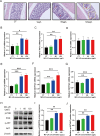Serum Microcystin-LR Levels Linked with Risk of Inflammatory Bowel Disease: A Matched Case-Control Study in China
- PMID: 39473886
- PMCID: PMC11503794
- DOI: 10.1021/envhealth.3c00212
Serum Microcystin-LR Levels Linked with Risk of Inflammatory Bowel Disease: A Matched Case-Control Study in China
Abstract
Microcystin-LR (MC-LR), the most prevalent and diverse cyanotoxin produced by harmful cyanobacterial blooms, has been linked to gastrointestinal toxicity. Therefore, we conducted a case-control study across four regions in China to investigate this relationship. Inflammatory bowel disease (IBD) cases (219) were matched with healthy controls (438) based on age and gender and conditional logistic regression models and Restricted cubic splines were used to evaluate the association between MC-LR exposure and IBD risk. We used quantitative real-time polymerase chain reaction to measure the expression levels of inflammatory factors. The levels of protein expression in the colorectum were determined using Western blotting (WB). Compared to the lowest quartile of serum MC-LR levels, the adjusted odds ratios and 95% confidence intervals (CI) for the highest quartiles of serum MC-LR levels were 5.51 (2.70, 11.21). The RCS was shown the association between serum MC-LR levels and IBD risk was nonlinear (P nonlinear < 0.001). In the animal experiments, MC-LR resulted in colorectal injury via the PI3K/AKT signaling pathway. Our study provides the evidence that serum MC-LR exposure is significantly associated with the risk of IBD in China. Animal study results indicate that MC-LR probably causes IBD via the PI3K/AKT signaling pathway.
© 2024 The Authors. Co-published by Research Center for Eco-Environmental Sciences, Chinese Academy of Sciences, and American Chemical Society.
Conflict of interest statement
The authors declare no competing financial interest.
Figures





Similar articles
-
Microcystin-LR Combined with Cadmium Exposures and the Risk of Chronic Kidney Disease: A Case-Control Study in Central China.Environ Sci Technol. 2022 Nov 15;56(22):15818-15827. doi: 10.1021/acs.est.2c02287. Epub 2022 Oct 21. Environ Sci Technol. 2022. PMID: 36269891
-
Serum microcystin levels positively linked with risk of hepatocellular carcinoma: A case-control study in southwest China.Hepatology. 2017 Nov;66(5):1519-1528. doi: 10.1002/hep.29310. Epub 2017 Sep 29. Hepatology. 2017. PMID: 28599070
-
Effects of Cyanobacterial Harmful Algal Bloom Toxin Microcystin-LR on Gonadotropin-Dependent Ovarian Follicle Maturation and Ovulation in Mice.Environ Health Perspect. 2023 Jun;131(6):67010. doi: 10.1289/EHP12034. Epub 2023 Jun 21. Environ Health Perspect. 2023. PMID: 37342990 Free PMC article.
-
Microcystin-LR in drinking water: An emerging role of mitochondrial-induced epigenetic modifications and possible mitigation strategies.Toxicol Rep. 2024 Sep 28;13:101745. doi: 10.1016/j.toxrep.2024.101745. eCollection 2024 Dec. Toxicol Rep. 2024. PMID: 39411183 Free PMC article. Review.
-
An overview of the toxic effect of potential human carcinogen Microcystin-LR on testis.Toxicol Rep. 2015 Jan 27;2:289-296. doi: 10.1016/j.toxrep.2015.01.008. eCollection 2015. Toxicol Rep. 2015. PMID: 28962362 Free PMC article. Review.
References
-
- Lloyd-Price J.; Arze C.; Ananthakrishnan A. N.; Schirmer M.; Avila-Pacheco J.; Poon T. W.; Andrews E.; Ajami N. J.; Bonham K. S.; Brislawn C. J.; et al. Multi-omics of the gut microbial ecosystem in inflammatory bowel diseases. Nature 2019, 569 (7758), 655–662. 10.1038/s41586-019-1237-9. - DOI - PMC - PubMed
LinkOut - more resources
Full Text Sources
